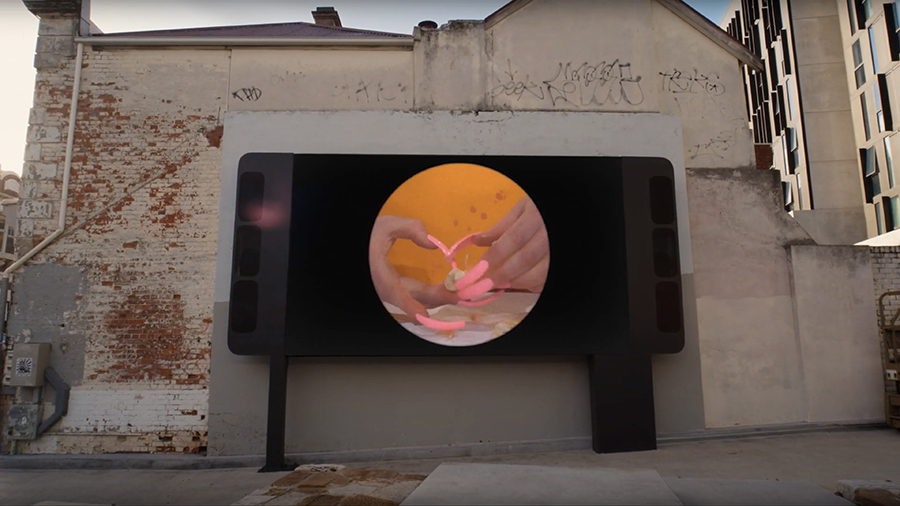The work captures visceral sensations that are otherwise untranslatable through words or speech.
Image: Sam Mountford,Sugartime, 2016, digital video with sound, photography Alexandra Hullah
SAM MOUNTFORD
On either side of the room containing the multimedia exhibition Boundaries at Contemporary Art Tasmania, two glowing crimson walls curve into timber skeletal frames, a porous wall gently coiling towards the centre, mimicking the whirl of swell, the inside swirl of a shell. Three screens bleed sound across this ‘intimate universe’[1] and each presents vignettes of On the Shoreline, a film by Sam Mountford and long-time collaborator Tess Campbell. In the centre of the room, two deck chairs angled towards the ceiling offer the final film viewing in repose.
The film itself spills between personal montage and processes of scientific research, flashing from aerial views of a marbled ocean, a hand rotating a microscope’s focus lens, the feathers of a dead seabird, pencil-drawn anatomical diagrams and coastal detritus viewed in cellular detail. The images are washed over with audio of intimate coastal imaginings. On The Shoreline emerged from a two-year engagement with scientist Peter Puskic, who shares the artists’ interest in the impact of marine pollution and plastic ingestion in seabirds. Through their gentle framing and delivery, Mountford and Campbell make bleak subject matter (conversely) digestible. I think of the way a shell, when pressed up against the ear, returns the red pulse of the listener’s own heartbeat.
A classical ballet dancer of 10 years, an avid journaler from a young age and always obsessive documenter, Mountford is attuned to the way architectural considerations direct bodies through a space – how written words form the kernel of ideas and the way moving images expand fields of vision. The duality of his collaborative filmmaking and solitary writing practice is mirrored by his repeated engagement with our shared experience of the crises of the climate emergency, and deep personal introspection.
This inwards-outwards motif also appears in The Furthest Corners (2020), screened at KINGS Artist-Run. The work begins with a mushroom-covered log held up close to the camera. ‘I wish I was a swamp monster,’ speaks a low, slow, garbled voice, ‘so I could swim underneath you/pull you under and drown you… leave the bones for the smaller fish’. A pair of feet becomes the protagonist, shown swinging in an algae-dotted pond, catching droplets from a drenched body, squelching bubbly laundry underfoot. The owner of the feet is soon revealed, squatting stiffly in a field with his face upturned to rainfall.
The work captures visceral sensations that are otherwise untranslatable through words or speech, while the absurdity of the audio arises from the meditations of the artist’s friends. The combination registers the dissonance between external and internal realities.
This alluring strangeness carries over to Mountford’s video contribution to Imagine The Earth is Your Lover, curated by Annie Sprinkle and Beth Stephens. Here, the artist pairs close-ups of the bark of a tree with a love poem read aloud that celebrates the eroticism of its features: ‘The nook of an armpit/the hook of a branch’.
Mountford speaks to me from the very place The Furthest Corners was filmed: Mora in the Alentejo region of Portugal, an hour and a half from Lisbon. There, as a long, hot and dry summer begins to wind down, the artist contemplates further study. The Samstag Scholarship supports his ongoing engagement with the country, which began in 2017.
An essay by Emma O’Neil following conversations with the Class of 2023 Samstag Scholarship recipients. Emma O’Neill is a writer, curator and arts manager based on Gadigal land.
[1][1] Bleach, Lucy, ‘Closer than breath’, Boundaries exhibition essay, January 2022.

